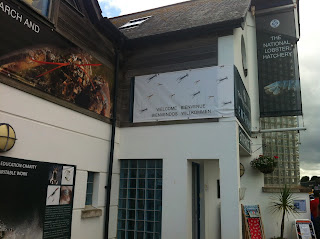An interesting side-product of some of my experiments have been the varying colours of the lobster haemolymph. I remember once watching QI and there was a question about lobster (or was it crab?) blood - and the 'correct' answer was that it was blue. But is this correct? I remember shouting at the TV at the time that it was wrong (I was a misunderstood lobsterologist, after all...)
When I was doing my PhD, I uploaded a photo to twitter which people went a little crazy for. It was from the experiments I talked about in my previous blogpost and it even surprised me. Each blood sample was a different colour! All the lobsters were from a similar location (Ilfracombe, Devon), similar size (92 - 100cm in carapace length) and mostly female. So, why, then, is there such a discrepancy... and most important of all... why aren't any blue?!!
When I was doing my PhD, I uploaded a photo to twitter which people went a little crazy for. It was from the experiments I talked about in my previous blogpost and it even surprised me. Each blood sample was a different colour! All the lobsters were from a similar location (Ilfracombe, Devon), similar size (92 - 100cm in carapace length) and mostly female. So, why, then, is there such a discrepancy... and most important of all... why aren't any blue?!!
 |
| Lobster blood samples for protein and metabolite quantification - the white bits are haemocyte pellets. Photo taken by Charlotte Eve Davies. |
First of all, let's get something straight. Lobsters don't have blood. I know I say it above and I will say it again, but as previously explained, lobsters don't really have blood. In fact, lobsters don't even have a 'closed' circulatory system like us (or mammals). Although they have a heart, which beats, and arteries, through which haemolymph (lobster 'blood') is passed through to bathe the organs, there are no veins to pass the haemolymph back to the heart. Instead, it returns to the heart via interconnecting spaces known as venous sinuses. For this reason, you will sometimes hear that the lobster's circulatory system known as an "open" circulatory system.
Okay, now that's out of the way, back to blue blood business. Some of us may have seen the (in)famous video or photos of bottles of horseshoe crab blood being decanted in a factory, for use in medical research... and we are wondering why my photo above doesn't show a similar brilliant blue hue? This is because, firstly, my samples were taken directly from a syringe, into a tube, which was closed, centrifuged and put in the freezer almost right away to stop the blood from clotting (the little white pellets you see are blood cells, or haemocytes, from the centrifugation). So the samples weren't exposed to much 'air' or namely, oxygen.
Okay, now that's out of the way, back to blue blood business. Some of us may have seen the (in)famous video or photos of bottles of horseshoe crab blood being decanted in a factory, for use in medical research... and we are wondering why my photo above doesn't show a similar brilliant blue hue? This is because, firstly, my samples were taken directly from a syringe, into a tube, which was closed, centrifuged and put in the freezer almost right away to stop the blood from clotting (the little white pellets you see are blood cells, or haemocytes, from the centrifugation). So the samples weren't exposed to much 'air' or namely, oxygen.
As mentioned in one of my previous blogs, haemocyanins are the crustacean version of our haemoglobin; they are proteins that bind and transport oxygen throughout the body. Haemocyanins contain two copper atoms that bind a single oxygen molecule (remember it's O2... not O1) rather than Iron, which is what binds to oxygen in human and most mammalian bodies. Now, it's oxygenation that causes a colour change between the colourless Cu(I) deoxygenated form and the blue Cu(II) oxygenated form which is why in some cases, a nice blue colour can occur, especially when exposed to the open air - air contains oxygen which reacts with the copper present in the blood, giving us the blue colour.
However, this is not always the case. Protein levels in the blood, or haemolymph, of lobsters, and all crustaceans, are constantly changing. This can depend on the stage in the moult cycle (i.e. is it about to shed it's shell to grow?), the reproductive status (whether it is about to try and find a mate, or lay eggs) or even whether a lobster is diseased or not. It was interesting that in my photo, one sample was very dark green (bottom row, 4th from the right) - we think that this may have been due to reabsorption of eggs. There is a protein, vitellogenin which is synthesized by the ovarian tissues in lobsters. During female maturation, extra-ovarian vitellogenin is transported through the hemolymph to the ovary and is taken up into the cytoplasm oocytes, or eggs. Egg reabsorption can happen for a umber of reasons, be it adverse conditions (if the lobster is stressed), or if the egg were released too early and the lobster then needs to moult.
More recerntly, during my first postdoc, I have been working on a virus in the Caribbean spiny lobster Panulirus argus. The virus, Panulirus argus Virus 1 (PaV1) has some interesting effects on the haemolymph of infected hosts. It turns it a very white, milky colour, rather than the usual amber colour, due to the degradation of hemocytes (blood cells). This is how we diagnose clinically infected individuals, pulling the tail away from the body a little and looking at the almost clear membrane covering the abdomen, it can clearly be seen whether or not an animal is infected.
So that's how we know... lobster blood isn't always blue.
















